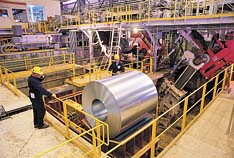
According to Alan McCoy, vice president, public affairs, for AK Steel, Middletown, OH, the company’s coated steel was introduced in February 2001 for carbon and stainless steels. “The HVAC world would primarily use carbon steel,” he said, although there could be applications for stainless, such as cleanrooms.
The steel’s AgION™ antimicrobial coating has been developed to inhibit the growth of bacteria, molds, fungi, and other microbes through the release of silver ions. The coating is said to provide continuous protection through the controlled release of its silver ions, which come in contact with any microbes that are present. The company says that researchers at a number of universities and research facilities have presented findings on ionic silver’s antimicrobial mechanism, which basically prevents respiration in microbes. AK Steel is doing in-use testing to show its effectiveness, and McCoy noted that the U.S. Environmental Protection Agency (EPA) has registered the use of the coating in HVAC applications as a deterrent to mold, mildew, fungus, and the like.

“The coating is durable, but you have to take normal precautions,” said McCoy. “You can remove a portion of the coating and still maintain efficacy in that area because of the ability of the ions to move around.”
Coating life depends on the application and surface wear, but you can expect “up to 30 years of service life,” he stated.
The antimicrobial action addresses dirty ductwork. It does not eliminate the need for cleaning. However, “We believe you can clean ducts less often” with the coating, he commented. It’s “a very cost-effective way to add a measure of cleanliness.”

PUTTING ON A COAT
Seal-Tite, a Hillsboro, OH-based sheet metal duct manufacturer, is using AK Steel’s coated carbon steel for the production of ducts, pipes, and fittings. The steel is coated on both sides. The exterior epoxy coating does not include the antimicrobial compound. This surface is for corrosion resistance.“It eliminates the typical white rust you see on galvanized,” said Mike Kelley, chairman and CEO of Seal-Tite. The interior coating has the added protection.
A translucent blue dye is used to clearly indicate which surface incorporates the antimicrobial compound.
The coated steel does not require any special handling, according to Kelley. “We process this steel through our normal machines, and it’s actually more durable than the typical galvanized.”

Homeowners and building owners are driving sales right now, Kelley indicated. They are specifying it for their projects. The company has been actively promoting it to wholesalers and contractors.
The strongest interest and purchasing to date has been among homeowners, but he pointed out that promising commercial application areas include schools, hospitals, and institutions.
His estimation of coating service life is that it should provide protection for the life of the duct installation. Duct applications normally do not see a lot of surface wear, he said. “As long as there’s coating on the metal, the antimicrobial compound is still working.”
For duct cleaning, “You would only need to avoid wire bristles.” Minor scratching will not cause a problem, he asserted. For small scratches on the coating of 1/4 inch or less, “The silver ions will migrate across to bridge the gap.”
Kelley related that there is a moderate price premium for the coating. “Coated ductwork will add from $1,000 to $3,000 to the price of an average home,” he remarked.
For optimum indoor air quality, he would recommend using the antimicrobial-coated ductwork along with ultraviolet (UV) light. Coupling it with UV light, which helps kill microbes at their source, provides “an excellent approach to a cleaner indoor environment.”
Publication date: 10/21/2002


Report Abusive Comment